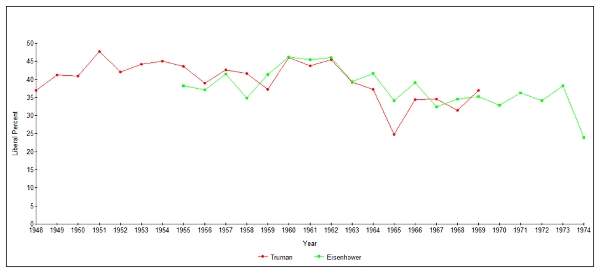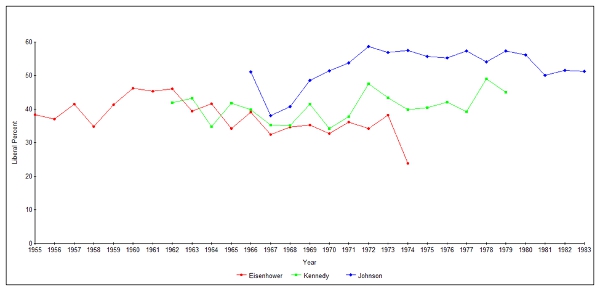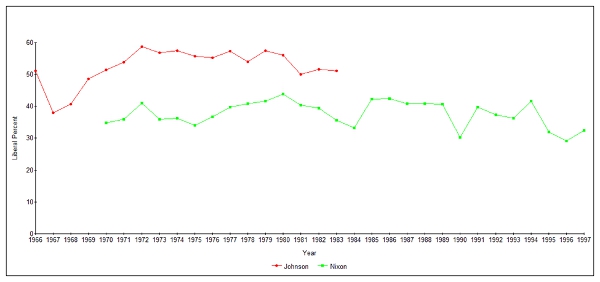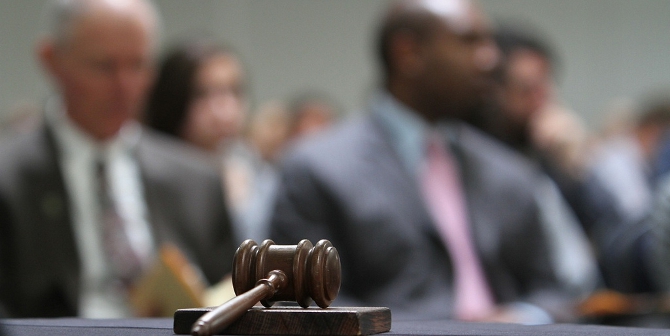

 The past four decades have seen Congress transformed into polarized camps of conservative Republicans and liberal Democrats. Given that Federal judges are nominated by partisans, have they become polarized as well? In new research which draws on a dataset of 90,000 federal district court cases over 80 years, Marc A. Sennewald, Kenneth L. Manning, and Robert A. Carp, that these courts have indeed become polarized. They write that this may be down to judges feeling less beholden to judicial precedent after the 1960s, presidents nominating those with similar ideologies to themselves, or that judicial polarization reflects the wider polarization of party elites.
The past four decades have seen Congress transformed into polarized camps of conservative Republicans and liberal Democrats. Given that Federal judges are nominated by partisans, have they become polarized as well? In new research which draws on a dataset of 90,000 federal district court cases over 80 years, Marc A. Sennewald, Kenneth L. Manning, and Robert A. Carp, that these courts have indeed become polarized. They write that this may be down to judges feeling less beholden to judicial precedent after the 1960s, presidents nominating those with similar ideologies to themselves, or that judicial polarization reflects the wider polarization of party elites.
In his January State of the Union Address, President Obama lamented that “the rancor and suspicion between the parties has gotten worse instead of better” during his time in office. The President, of course, was acknowledging the ideological divide that animates Congress; the Democratic Party has become increasingly dominated by liberals and the Republican Party by conservatives. Indeed, Americans have come to accept and expect that their representatives in Congress, as well as the President, will reflect the ideology of their respective parties.
The polarization described by the President and experienced by the American people is well documented, though it began long before Obama. In their ground-breaking work on roll call voting in Congress, Keith Poole and Howard Rosenthal showed how the ideological consensus that marked the immediate post-World War II period dissolved in the mid-1970s, pushing Congress into separate liberal and conservative camps.
But consider the third branch of government, the judiciary. Do judges reflect the ideology of their respective parties when they make decisions in individual cases? Has the judiciary, like Congress, also become polarized?
In new research, we investigated the extent to which ideological polarization has affected the federal judiciary. Specifically, we wanted to know if Democratic judges became more liberal and Republicans more conservative over time.
In order to test our hypothesis, we drew on a dataset of 90,000 federal district court cases decided between 1927 and 2008 compiled by Robert Carp and Ken Manning. We identified each decision as either a liberal decision or a conservative one. The data also include the political party affiliation of each judge before he or she was appointed to the bench, as well as the president who appointed the judge. From this data, we calculated annual liberalism scores based on the party identification of district court judges and the liberal/conservative direction of their decisions. We then plotted these scores over time.
Our results indicate that the federal district courts have indeed become polarized. Figure 1 shows that from 1934 to 1966, there is little differentiation between Democratic judges and Republican judges. The lines cross numerous times. During this period, judges with a Democratic Party affiliation decided cases in a liberal direction 44.1 percent of the time, while judges affiliated with the Republican Party decided cases in a liberal direction 41.5 percent of the time. The margin of difference between the two groups of judges is 2.6 percentage points.
Figure 1 – Liberal Percent 1934 – 2008

From 1967 onwards, however, Democratic judges are consistently more liberal than their Republican counterparts. During the 1967 to 2008 period, Democratic judges decided cases in a liberal direction 46.8 percent of the time and Republican judges decided cases in a liberal direction 36.6 percent of the time. The margin of difference between Democratic judges and Republican judges is 10.2 percentage points. The data clearly show that the district courts began to polarize during the 1960s and have remained polarized.
The polarization of the courts becomes more apparent when we break the data down into presidential cohorts. Figure 2 illustrates the post-war consensus between the parties, showing the similarity between the judges appointed by Truman and Eisenhower. Overall, the Truman cohort is slightly more liberal, deciding cases in a liberal direction 40.2 percent of the time versus 37.6 percent of the time for the Eisenhower cohort. Where the cohorts overlap and are directly comparable, however, even this small difference disappears. In cases decided between 1955 and 1969, both the Truman and Eisenhower cohorts decided cases in a liberal direction 39.2 percent of the time.
Figure 2 – Liberal percent, Truman and Eisenhower cohorts

Figure 3 shows the parties beginning to polarize. The Kennedy cohort is slightly more liberal than the Eisenhower cohort, yet much more conservative than the Johnson cohort. Decisions by the Eisenhower and Kennedy cohorts track each other closely during the 1960s and then diverge in the 1970s. Partisan decision making appears with Johnson’s judges, who are consistently more liberal than Eisenhower’s and Kennedy’s judges.
Figure 3 – Liberal percent, Eisenhower, Kennedy and Johnson cohorts

Figure 4 shows that by the 1970s, the judiciary had polarized. The Johnson cohort is substantially more liberal than the Nixon cohort. Johnson’s judges decided cases in a liberal direction 51.7 percent of the time versus 37.9 percent of the time for Nixon’s judges. During the period when the cohorts overlap, from 1970 to 1983, the difference between the cohorts is even more pronounced, with the Johnson cohort deciding cases in a liberal direction 55.7 percent of the time and the Nixon cohort deciding cases in a liberal direction 38.2 percent of the time. The margin of difference is 17.5 percentage points. Judges appointed by subsequent Democratic and Republican presidents reflect a similar pattern of polarized decision making.
Figure 4 – Liberal percent, Johnson and Nixon cohorts

Our data does not tell us why the courts have become polarized, but there are several possible explanations. One theory is that judges began to feel less constrained by the doctrine of precedent in the late 1960s and simply began to make decisions according to their inherent partisan values.
Another theory is that Johnson and Nixon pioneered a new way of asserting presidential power by consciously appointing ideological fellow travellers to the bench. In this they were so successful that subsequent presidents followed their lead. This top-down theory emphasizes the power of the president to shape the federal bench.
A third possible explanation, which we describe as bottom-up polarization, is that the polarization of the district courts is essentially a function of the polarization of the elite class of party members from which judges are drawn. In this view, party elites began to sort themselves ideologically in the 1960s, with liberals moving to the Democratic Party and conservatives to the Republican Party. Because presidents overwhelmingly appoint members of their own party to the bench, a polarized judiciary became largely unavoidable as the parties moved apart in ideological space. The implication of bottom-up polarization is that judicial decision making is an ideological phenomenon that transcends the president.
Partisan decision making affects how disputes are resolved, rights are protected and justice is dispensed. A polarized judiciary undermines the rule of law and detracts from the legitimacy of judicial institutions.
This article is based on the paper, ‘The polarization of the judiciary’, in Party Politics.
Image credit: Shawn Calhoun (CC-BY-NC-2.0)
Please read our comments policy before commenting.
Note: This article gives the views of the author, and not the position of USAPP – American Politics and Policy, nor the London School of Economics.
Shortened URL for this post: http://bit.ly/1nVKa9H
_________________________________
 Marc A. Sennewald – University of Houston
Marc A. Sennewald – University of Houston
Marc A. Sennewald has lectured in law and politics at the University of Houston. His research interests include judicial behavior and political parties.
 Kenneth L. Manning – University of Massachusetts-Dartmouth
Kenneth L. Manning – University of Massachusetts-Dartmouth
Kenneth L. Manning is Professor of Political Science at the University of Massachusetts-Dartmouth. His research focuses on American politics, judicial decision-making, and the federal judicial selection process. He is coauthor of Judicial Process in America (Sage/CQ Press) and of numerous articles in academic journals.
 Robert A. Carp – University of Houston
Robert A. Carp – University of Houston
Robert A. Carp is a professor of Political Science at the University of Houston where he has served since 1969. He is the author of fifty-one authored or co-authored peer-reviewed articles in the realms of judicial process, law and society, and judicial behavior. Two of his most recent co-authored books include: Politics and Judgment in Federal District Courts, University Press of Kansas, 1996; and Judicial Process in America, 10th edition, Congressional Quarterly Press, 2017.



